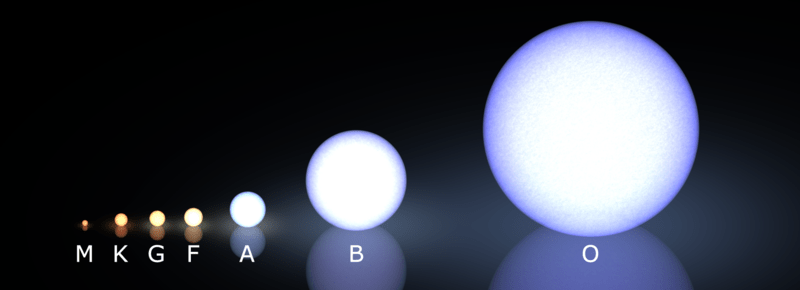[/caption]
Look into the night sky and you’ll see stars in all directions shining and twinkling in the dark. But what is the light that we’re seeing, and how does it get all the way from the distant stars to here?
All stars are just vast balls of hot plasma. They’re made up of mostly hydrogen and helium, with trace amounts of other elements. Mutual gravity holds the star together, and compresses it inward. Without some kind of force pushing back, stars would just compress themselves down to the size of the Earth, or even smaller.
But as a star gets smaller, the gravitational friction causes it to heat up in its core. When the core of the star reaches about 15 million Kelvin, hydrogen fusion can begin. In this process, atoms of hydrogen are crushed together through a multi-stage process to form helium. This reaction is exothermic, which means that it gives more energy than it gives off. A star like the Sun is releasing 3.86 x 1026 joules of gamma radiation every second.
These photons of energy are trapped inside the star and have to get out. Over a journey that can take more than 100,000 years, the photons are continuously emitted and then absorbed by atoms in the Sun. Each of these jumps can cause the photon to lose energy. When they finally reach the surface of the star, they’ve lost a tremendous amount of energy, and have fallen from high energy gamma rays down to visible wavelengths.
And then, the photons are released from the surface of the star, and free to cross the vacuum of space. Unless they encounter anything, they’ll keep traveling in a straight line for millions, billions and even trillions of years. When you step outside and look at a star that could be a few hundred light-years away, your eyes are the first things the photons have bumped into since they left the surface of the star!
We have written many articles about stars here on Universe Today. Here’s an article about the biggest star in the Universe, and here’s an article about how many stars there are in the Milky Way.
If you’d like more information on stars, check out Hubblesite’s News Releases about Stars, and here’s the stars and galaxies homepage.
We have recorded several episodes of Astronomy Cast about stars. Here are two that you might find helpful: Episode 12: Where Do Baby Stars Come From, and Episode 13: Where Do Stars Go When they Die?
References:
http://www.jet.efda.org/fusion-basics/what-is-fusion/
http://www.ips.gov.au/Category/Educational/The%20Sun%20and%20Solar%20Activity/General%20Info/Solar_Constant.pdf

